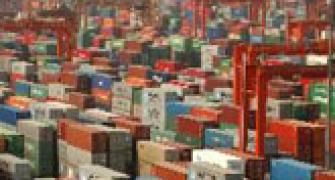 A sharp rise in rupee value against dollar has added to the woes of exporters, who want the government to step in and peg the fixed exchange rate, taking a cue from China.
A sharp rise in rupee value against dollar has added to the woes of exporters, who want the government to step in and peg the fixed exchange rate, taking a cue from China.
The US dollar has shown a decline of about 12 per cent in the last one year, as the foreign institutional investors (FIIs) pumped in huge inflows.
They brought in $4.1 billion in the last three months. As the FIIs were betting high on the Indian economy, dollar dropped to a 19-month low to sub Rs 45 level. Dollar depreciation results in lower margins for the exporters because they realise less value for the foreign exchange in terms of local currency.
After 13-month rout since October 2008, exporters managed to return to growth from November 2009 as the world economy is recovering from the worst recession in the last six decades.
India's exports for fiscal ending March 31 are expected to drop to $160-165 billion from $185 billion in 2008-09.
Demanding a fixed exchange rate of Rs 47.5 to a dollar for one year, the Federation of Indian Export Organisations (FIEO) demanded the government to regulate the FIIs.
"FIIs are making short-term profits. There is a need to regulate their investment. Moreover the government can contemplate providing a fixed rate of exchange for exports on optional basis," FIEO President A Sakthivel said.
He said China and Bangladesh are providing fixed exchange rates for the last few years and "reaping the benefits." Engineering goods exporters, the third largest contributors to the export kitty, felt that the drop in dollar rate would delay the recovery in their business, which has not so far turned positive.
"Engineering exports have declined by 20 per cent during April-January 2010. This will get further aggravated if the rupee continues to appreciate," Executive Director of EEPC (Engineering Export Promotion Council) R Maitra said.
Employment-oriented export sectors like carpet and handicrafts would feel the brunt of rupee appreciation.
"Incentives of around 5-7 per cent given to us in Foreign Trade Policy have been washed out by the currency movement," Chairman of the Export Promotion Council for Handicraft Raj Kumar Malhotra said.
Carpet exporters, mostly in the small scale sector, fear the business defaults as the manufacturers may not be able to execute the orders book at the old exchange rate.
"Rupee appreciation is not good at a time when our exports are at initial stage of recovery from the slowdown," Rakesh Mohan Joshi of Indian Institute of Foreign Trade said. Almost of 70 per cent of India's foreign trade is dollar denominated.








